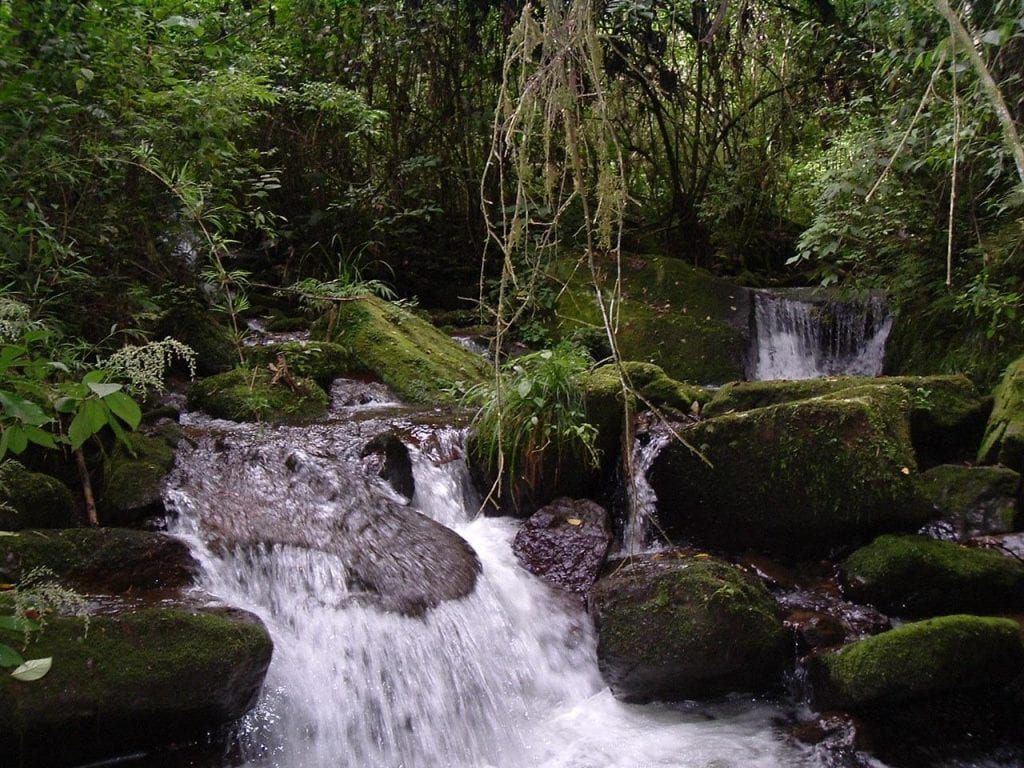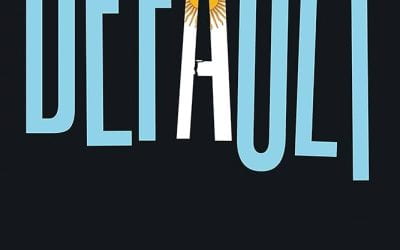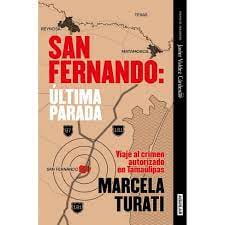Reciprocal Agreements for Water
An environmental management revolution in in the Santa Cruz valleys

Small streams from inside Amboro National Park feed the Los Negros River and provide important irrigation water. Photo courtesy of Nigel Asquith
September 21, 1967. A hot wind sweeps tumbleweed through the village of Alto Seco. Women peer from behind drawn shutters, to catch a glimpse of the visitors who arrived earlier in the day. They had walked slowly into the village, carrying immense backpacks. The men made camp in an abandoned house next to a waterhole, and during the evening talked to a group of 15 amazed and silent peasants: “The government has abandoned Alto Seco: you have no healthcare, no paved road, and no clean water.” “But don’t worry” said Comandante Che Guevara. “We’re here to help. We’re communists.”
September 21, 2010. The same hot wind still sweeps tumbleweed through Alto Seco. Little has changed: villagers greet visitors with the same guarded suspicion, and Alto Seco still has no healthcare, no paved road, and no clean water. “But don’t worry” said Maria Teresa Vargas, the leader of the latest group of visitors. “We’re here to help. We’re conservationists.”
Claudio Gutiérrez could do with the help. With each passing year, he sees fewer rain clouds above his farm. Rainfall has halved in the 50 years since Che and his guerrillas passed through the Santa Cruz valleys, and with current rates of deforestation, Claudio expects that in five years the Masicuri River and his spinach fields will be dry all winter. Claudio’s ten cows, his only other income source, struggle to find water. They spend most of their time close to the temporary streams: compacting soil, eroding the stream banks, polluting the water and grazing on the few remaining forest tree seedlings.
The upland forests of the Santa Cruz valleys are also increasingly threatened by illegal land incursions. Encouraged by farmers’ unions and local leaders, landless migrants from the altiplano are entering the region to clear water-producing cloud forests for agriculture. Deforestation and forest degradation in the Mosqueras and Vilcas watersheds of Cruceño Valleys increased by almost 500% between 1986 and 2004, while downstream flooding over the same period caused $250 million in damages. In 2006, floods in the lower Rio Grande destroyed more than 250,000 acres of soy and other crops.
Except where they suffer intense grazing pressure, the eastern slopes of the Andes support some of the world’s most biodiverse forests. Bordering the northern edge of the Santa Cruz valleys is Amboró National Park, home to 10% of all the bird species on planet earth. The 100 square mile Los Negros Valley supports 235 resident bird species, almost a quarter of the number found in the whole of North America. These forests have other uses too: the region provides drinking water to the 1.5 million residents of Santa Cruz, and supplies irrigation water and flood protection to the fertile lowlands where soy producers drive Bolivia’s agricultural export economy.
Deforestation and cattle-grazing—a tragedy of commons exacerbated by climate change—are fundamentally changing the Santa Cruz valleys. The valleys are fast losing their ability to provide food, water and other environmental services to their residents, while the farmers are as poor as they were when Che failed to persuade them to rise up and revolt. Water scarcity has led to reduced agricultural yields, and of the 3,000 children in the region, almost a sixth spend significant time out of school, suffering from diarrhea caused by drinking water contaminated by their families’ own cows.
In early 2003 in the municipality of Pampagrande, in the small village of Santa Rosa de Lima, a quiet revolution began. At a meeting facilitated by a non-governmental organization, Fundación Natura Bolivia, five downstream irrigators negotiated a groundbreaking deal with their upstream counterparts. “For every 25 acres of forest you conserve for a year,” Andrés Rojas told Serafín Carrasco, “we will give you one beehive and training on how to produce and sell honey.” And so the first reciprocal agreement for water was struck.
By 2010, the initial five Santa Rosa farmers protecting 1,235 acres had mushroomed to 63 families conserving 10,000 acres. The scheme had spread to neighboring Comarapa and Mairana municipalities, which protected another 12,000 acres through conservation contracts. The crucial innovation, though, is not just that upstream farmers have signed contracts to conserve their forests. What really is noteworthy is that the downstream water users are paying for the schemes. In 2007, residents of Los Negros, Comarapa and Mairana voted to increase their water tariffs by 9%, 15% and 7% respectively.
In Comarapa, for example, every $20 invested by Fundación Natura Bolivia and its donors is matched by $30 of local funds, which together purchase a beehive to compensate for conservation of 5 acres of water-producing forest for five years. Honey revenue per acre of forest conserved is $10 per year, so within five years the landowner has not only used the $20 of donor funds to conserve five acres of forest, but has also sold $50 worth of honey. Forest conservation and watershed management have thus been transformed from unenforceable top-down impositions by central government, to negotiated agreements among participating equals.
While the details of each municipal scheme differ, the basic concept is the same everywhere. Three parties sign a ten-year agreement: the water co-operative opens a separate bank account, into which revenues from the new “environmental services” tariff are channeled, the municipal government agrees to annual purchase of beehives, fruit tree seedlings, irrigation pipes or other development tools, to be given in compensation for forest conservation activities, and Fundación Natura invests cash from its donors, and provides technical support to get the scheme up and running.
Maria Teresa Vargas of Natura explains: “the model is cheap, efficient and transparent. Each party pays its own costs, including technician salaries, fuel and other expenses, so that every single dollar that enters the water fund is invested in upstream conservation. The accounts of the water co-operatives are open for all members to see, so there is simply no space for mismanagement or misappropriation of funds”.
In 2007 the concept was scaled up a level when Rubén Costas, the Governor of the Department of Santa Cruz, created a new 1.8 million-acre protected area to conserve the forested headwaters of the Santa Cruz valleys. The Rio Grande-Valles Cruceños Protected Area filled a hole in Bolivia’s conservation map, creating a biodiversity corridor between Amboró and Iñao National Parks, and, like a virus, the water fund concept replicated into Moro Moro, Vallegrande, Postrervalle, Samaipata and Pucara municipalities.
In Pucara, close to Alto Seco, Claudio Gutiérrez took some convincing. “Visitors have been coming and going from Pucara since before the time of Che,” he asserted. “They come with so many promises, and always end up providing nothing.” But once the Pucara hydroelectric cooperative and municipal government offered Claudio six beehives and training and equipment for honey production—a value of more than $600—in exchange for the conservation of 75 acres of his water-producing cloud forests, he was converted. Claudio is slowly convincing the rest of his family, starting with his brothers Jesús, Carlos and José, that the scheme can also work for them.
A more important question for Natura Bolivia is whether the local water funds achieve their stated goal. “While it all sounds great on paper,” notes Maria Teresa Vargas, “we haven’t yet proven that these funds really are catalyzing new conservation in areas which otherwise would be degraded or deforested, and if local people really have received benefits that would not have occurred without the funds.”
This lack of knowledge about the impact of conservation activities is not unique to the Santa Cruz water funds. Across the globe, conservation initiatives large and small have rarely been subject to scientific analysis of their effectiveness. Instead, conservationists have depended on intuition and anecdote to guide the design of investments. This makes little sense: as Paul Ferraro and Subhrendu Pattanyak suggested in 2006 (in PLOS Biology): “If we want to ensure that donors’ limited resources make a difference, we must accept that testing hypotheses about what policies and interventions protect environmental services requires the same scientific rigor and state-of-theart methods that we invest in testing ecological hypotheses.”
Understanding of the ecological aspects of conservation rests, in part, on well-designed empirical studies. In contrast, our understanding of the way in which policies can help protect biodiversity rests primarily on anecdotal monitoring of projects that were not even designed to answer the question, “Does this intervention work better than no intervention at all?” Sadly, we thus have no idea if the billions of dollars invested in conservation in the last decades have actually achieved anything.
In 2009, Fundación Natura Bolivia approached Kelsey Jack at Harvard’s Sustainability Science Program to try to develop a program evaluation: a study that could show, once and for all, whether giving farmers like Claudio Gutiérrez direct incentives to conserve their land could achieve cost-effective conservation and development. Jack and Harvard colleagues then spent a year and half with Natura figuring out how such an experiment could best be implemented. Following the logic of the natural sciences, the analysis is straightforward in its design. However, it is costly, complex, and slow in its implementation.
To establish a baseline, every single family in the Rio Grande-Valles Cruceños Protected Area initially completed a 15-page questionnaire about their socioeconomic situation, their perceptions about the environment and the role of various institutions in their lives. At the same time, researchers measured water quality in, above, and below each community, mapped vegetation cover, and assessed the diversity of beetles and amphibians in each community’s forests. Fundación Natura technicians then returned to all 120 communities to report back on results of the data collection process; to explain to the farmers how current land practices such as extensive cattle grazing are destroying the environment and their own water supplies; and to demonstrate the economic viability of alternative productive activities such as honey and fruit production, and rationalization of cattle ranching.
In August 2011, the experiment itself finally began. Through a simple lottery conducted in front of local officials, 60 communities—half of the communities in the area—were selected to receive funding for reciprocal agreements. All farmers in the selected communities who own land within 300 feet of streams and rivers are eligible to receive in-kind payments—i.e. fruit trees or bee boxes—at the equivalent rate of $2 per acre of water- producing forest conserved for a year.
Farmers in the other 60 communities will receive nothing other than information about the state of the environment, and follow up data collection will indicate whether there is more effective conservation in the sites where compensation is paid, and if these payments have had an effect on local livelihoods and perceptions about the environment and local institutions. Once the experimental results are in, farmers in the 60 “nontreated” communities will then become eligible for the scheme.
Critics of such program evaluations assert that they are unfair (“How can you deny project benefits to some communities and not others?”) and unethical (“How can researchers justify ‘playing god’ with people’s lives?”). Harvard’s Kelsey Jack explains:
“All conservation and development project face financial constraints, yet we actually don’t know if many popular interventions work or not. There is no better way of assessing whether an intervention actually works than through a randomized experiment, and, given that project resources are finite, there is no fairer way to allocate funds to communities than in a random draw. Our methodology randomly assigns which communities receive the project first, and we use this ‘experiment’ to then scientifically assess if the project actually works or not. What is increasingly clear is that effective conservation and development requires evidence about what works, including the sometimes surprising ways that potential beneficiaries respond to the proposed interventions.”
Just ask Che. His communist revolution in the Santa Cruz valleys ground to an abrupt halt—mainly because he didn’t understand his audience’s needs, and they weren’t convinced that he could help them. Perhaps Natura Bolivia’s conservation effort, led by people from the region, addressing a recognized local problem, will have more success. “We will keep fighting to protect the people’s water supplies,” asserts Maria Teresa Vargas of Natura: “Hasta la victoria siempre.” Unlike the events of 1967, a rigorous experimental methodology will determine whether Natura’s revolution really is victorious or not.
Related Articles
A Review of Default: The Landmark Court Battle over Argentina’s $100 Billion Debt Restructuring
In February 2019, I found myself serving as the special attorney general for the then newly recognized interim government of Venezuela, tasked with addressing more than 50 claims before the U.S. courts stemming from the $140 billion debt inherited from Hugo Chávez and Nicolás Maduro.
A Review of Until I Find You: Disappeared Children and Coercive Adoptions in Guatemala
A student in my “Introduction to Cultural Anthropology” course at the University of Delaware approached me several weeks ago, after hearing about my long-term research in Guatemalan communities, to tell me that they were born there, in Guatemala.
A Review of San Fernando: Última Parada, Viaje al crimen autorizado en Tamaulipas
One of Mexico’s best investigative journalists, Marcela Turati, takes readers to terrorized and traumatized San Fernando, a town known for dozens of mass graves, and exposes the depths of criminal brutality and official corruption that hid the bodies and the truth for years.




